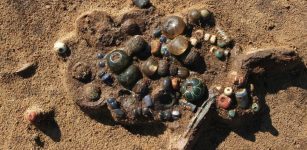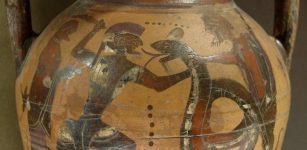Why Are Statues Of Mythical Yeti Dividing People In The Himalayas?
Jan Bartek – AncientPages.com – Yeti has always been a troublesome mythical creature. People have argued over his existence for years and many claim they've sighted this elusive giant ape-like creature roaming the Himalayas.
Yeti is believed to be a large snowman roaming the Himalayas. Credit: Public Domain
A large number of Yeti sightings hasn’t impressed scientists who argue Yeti cannot be real. Some years ago, a science team traveled to the Himalayas looking for Yeti. They investigated, wrote a report and made all Yeti believers disappointed. The science team led by geneticist Charlotte Lindqvist said the rare Himalayan brown bear is one possible origin of the Yeti legend.
Is Yeti A Large Bear?
In a study, Lindqvist and her colleagues described how they used DNA to examine nine alleged Yeti samples. Among them was a thigh bone discovered by a spiritual healer in a cave, hair from a mummified animal kept at a monastery, a tooth from a stuffed animal found in by Nazis in the 1930s, and other less significant samples. The results of Lindqvist’s DNA study led to the conclusion that Yeti was just a bear. Previous genetic studies led to similar conclusions. Bryan Sykes, a geneticist at Oxford examined alleged Yeti DNA samples and declared this mythical creature was an ancient 40,000-year-old polar bear, and possibly a hybrid bear.
To promote tourism, new statues of Yeti will be placed across the country and people don't like them. Credit: BBC
But devoted Yeti believers refuse to listen to the scientific community and claim Yeti is a mythical beast because it is described as such in folktales.
“The yeti is known throughout the Tibetan plateau and into the Trans-Himalaya regions of the Kun Lun Mountains and Altai Himalaya.
See also:
European Mythical Creatures Encountered In The Witcher Series
Makara – Legendary Sea-Creature With Many Incarnations In Hindu Mythology
In Mongolia he is known by the name “wildman” or “wild people“— almas (singular) or in other dialects, almasty or almasti. The most common name in Tibet for the yeti is dremo. In eastern Tibet, near Bhutan, they are called nydag shidag, and are thought to be guardians of certain areas.
Apes do not live in the high plateau mountain regions of Tibet, Mongolia, Russia and Central Asia, so the yetis of this region have usually been associated with wildmen, rather than with some sort of giant ape, as in Nepal, Bhutan and Southeast Asia. Almases are usually described as human-like with their bodies covered with reddish-brown hair. They are said to be between five and six and a half feet tall, with anthropomorphic facial features including a pronounced browridge, flat nose, and a weak chin. In many ways they are identical to the yeti.” 1
Yeti Statues Upset People
This time, however, people are not arguing over Yeti’s existence but the creature’s appearance.
Nepal’s government ordered more than 100 statues made in the image of Yeti. When people saw the first statue, they were furious because it looks like a sumo wrestler and not a mythical ape-like creature.
These Yeti statues are meant to be placed at various tourist locations across the country. The goal was to turn Yeti into a mascot and attract tourists, but people are not impressed, and even cultural historians say these depictions are disrespectful towards the nation’s popular mythological creature.
However, the Yeti Art Committee that is responsible for the production of these new Yeti statues defends itself stating that this is a mythical character, and there must be room for creative freedom.
"Our aim is to produce the yeti as an emblem of peace, reconciliation, and humility rather than a fear-creating feature," he told the BBC.
"People around the world should not only know Nepal as the land of Everest or Lord Buddha or Gurkha. The yeti can represent our uniqueness as well."
Another Yeti statue. The creature doesn't look like people imagined. Credit: BBC
Ang Tsherin Sherpa, the man responsible for the controversial design is equally defiant.
"I did not make yeti's sketch by reading any book," he explained. "On the basis of stories that I heard in my childhood and having Lord Buddha at the back of my mind, I made the design."
These arguments may be valid, but people are still not happy about these new statues.
What do you think? Should the Yeti statues be considered a good promotion tool making tourists curious about Himalayan folklore or are the unusual depictions of Yeti insulting?
Written by Jan Bartek - AncientPages.com Staff Writer
Copyright © AncientPages.com All rights reserved. This material may not be published, broadcast, rewritten or redistributed in whole or part without the express written permission of AncientPages.com
Expand for references- David Hatcher Childress - Yetis, Sasquatch & Hairy Giants
- Kamal Pariyar - Visit Nepal's yeti: How mythical creature divided Himalayan nation, BBC
- Tianying Lan, Stephanie Gill, Eva Bellemain, Richard Bischof, Muhammad Ali Nawaz and Charlotte Lindqvist - Evolutionary history of enigmatic bears in the Tibetan Plateau–Himalaya region and the identity of the yeti284Proc. R. Soc. Bhttps://doi.org/10.1098/rspb.2017.1804
- Bryan C. Sykes, Rhettman A. Mullis, and Michel Sartori - Genetic analysis of hair samples attributed to yeti, bigfoot and other anomalous primates, https://www.ncbi.nlm.nih.gov/pmc/articles/PMC4100498/
More From Ancient Pages
-
![Photo taken on Dec 20, 2015 shows hoof-shaped gold ware unearthed from the main coffin in the Haihunhou (Marquis of Haihun) cemetery, East China's Jiangxi province. [Photo/Xinhua]](https://www.ancientpages.com/wp-content/uploads/2015/12/MarquisofHaihuntomb1-307x150.jpg) Does A 2,000-Year-Old Tomb Belong To Marquis of Haihun? – Search For His Seal Continues
Archaeology | Dec 25, 2015
Does A 2,000-Year-Old Tomb Belong To Marquis of Haihun? – Search For His Seal Continues
Archaeology | Dec 25, 2015 -
 Why Did Sages And Shamans Repeatedly Visit The Mysterious Finnish Pirunkirkko Cave (Devil’s Church)?
Archaeology | Nov 27, 2023
Why Did Sages And Shamans Repeatedly Visit The Mysterious Finnish Pirunkirkko Cave (Devil’s Church)?
Archaeology | Nov 27, 2023 -
 Zapotecs’ Magnificent City Of Mitla Was Destroyed By A Seismic Landslide
Archaeology | Aug 23, 2024
Zapotecs’ Magnificent City Of Mitla Was Destroyed By A Seismic Landslide
Archaeology | Aug 23, 2024 -
 Ancient Pathogens Released From Melting Ice Could Wreak Havoc On The World – New Analysis Reveals
Featured Stories | Aug 2, 2023
Ancient Pathogens Released From Melting Ice Could Wreak Havoc On The World – New Analysis Reveals
Featured Stories | Aug 2, 2023 -
 Ancient Textile Mystery: King Canute Enshrined In His Own Clothes But Found In His Brother’s
Artifacts | Oct 5, 2020
Ancient Textile Mystery: King Canute Enshrined In His Own Clothes But Found In His Brother’s
Artifacts | Oct 5, 2020 -
![Horses in the Eurasian steppes: Already 5000 years ago, they served pastoralists as a source of milk and a means of… [more] © A. Senokosov](https://www.ancientpages.com/wp-content/uploads/2021/09/pastoraliststeppe15-307x150.jpg) Milk Enabled Massive Steppe Migration – A New Study
Archaeology | Sep 24, 2021
Milk Enabled Massive Steppe Migration – A New Study
Archaeology | Sep 24, 2021 -
 Only One In Four Western Roman Emperors Died Of Natural Causes
Archaeology | Oct 15, 2021
Only One In Four Western Roman Emperors Died Of Natural Causes
Archaeology | Oct 15, 2021 -
 Cremation In The Near East Dates Back To 7,000 B.C.
Archaeology | Aug 13, 2020
Cremation In The Near East Dates Back To 7,000 B.C.
Archaeology | Aug 13, 2020 -
 40 Elite Graves Of Men, Women And Children Unearthed On Danish Island Of Bornholm
Archaeology | Feb 3, 2017
40 Elite Graves Of Men, Women And Children Unearthed On Danish Island Of Bornholm
Archaeology | Feb 3, 2017 -
 Warrior Uesugi Kenshin And His Nagamaki Special Guards
Featured Stories | Sep 4, 2018
Warrior Uesugi Kenshin And His Nagamaki Special Guards
Featured Stories | Sep 4, 2018 -
 65 Byzantine-Era Tombs Unearthed In Stratonikeia – World’s Largest Marble City
Archaeology | Feb 24, 2017
65 Byzantine-Era Tombs Unearthed In Stratonikeia – World’s Largest Marble City
Archaeology | Feb 24, 2017 -
 3,500-Year-Old Egyptian Tomb Of Guardian Of Pharaoh’s Secret Archive Discovered In Saqqara
Archaeology | May 7, 2022
3,500-Year-Old Egyptian Tomb Of Guardian Of Pharaoh’s Secret Archive Discovered In Saqqara
Archaeology | May 7, 2022 -
 Unusual Archaeological Object Reveals Traces Of Prehistoric Settlements Mikołajki
Archaeology | Jun 19, 2023
Unusual Archaeological Object Reveals Traces Of Prehistoric Settlements Mikołajki
Archaeology | Jun 19, 2023 -
 Was Hygiene Important For Our Ancestors?
Featured Stories | Feb 11, 2017
Was Hygiene Important For Our Ancestors?
Featured Stories | Feb 11, 2017 -
 Biblical City Of Gezer: Important Ancient City Mentioned In The Amarna Letters
Biblical Mysteries | Sep 6, 2018
Biblical City Of Gezer: Important Ancient City Mentioned In The Amarna Letters
Biblical Mysteries | Sep 6, 2018 -
 Ancient City Of Uxmal And Magnificent Pyramid Of The Magician
Featured Stories | Dec 19, 2015
Ancient City Of Uxmal And Magnificent Pyramid Of The Magician
Featured Stories | Dec 19, 2015 -
 What Was The Symbolism Behind Native American Feathers?
Ancient History Facts | Apr 21, 2017
What Was The Symbolism Behind Native American Feathers?
Ancient History Facts | Apr 21, 2017 -
 Cadmus – Legendary Phoenician Hero And Founder Of Prosperous City Of Thebes
Featured Stories | Sep 6, 2023
Cadmus – Legendary Phoenician Hero And Founder Of Prosperous City Of Thebes
Featured Stories | Sep 6, 2023 -
 Huge Ancient Ceramic Workshop With Hundreds Of Stunning Artifacts Solves An Archaeological Mystery In Israel
Archaeology | Dec 14, 2020
Huge Ancient Ceramic Workshop With Hundreds Of Stunning Artifacts Solves An Archaeological Mystery In Israel
Archaeology | Dec 14, 2020 -
 Ancient Secret Tunnel Discovered Beneath The Pyramid Of The Moon In Mexico’s Teotihuacan
Archaeology | Jul 8, 2017
Ancient Secret Tunnel Discovered Beneath The Pyramid Of The Moon In Mexico’s Teotihuacan
Archaeology | Jul 8, 2017



